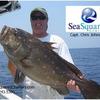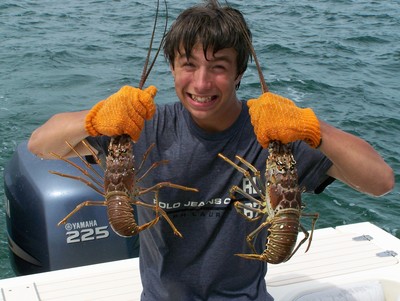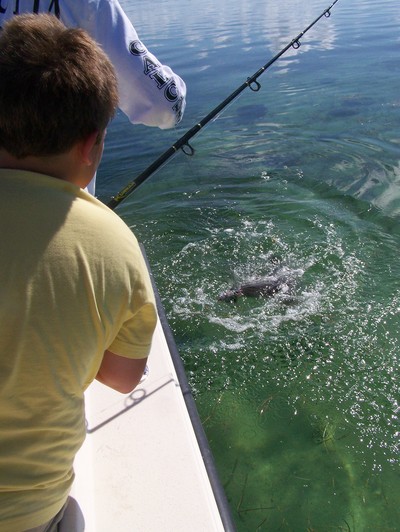If the past two months are any indication of things to come, August should be slamming with everything from dolphin, tuna, marlin and swordfish to snapper and grouper. Regardless of your target species, you will have greatest success during the low light periods of early morning, evening or even at night. The midday heat quite often puts the fish off their feed for a span of a few hours, with the exception of the billfish.
Offshore, dolphin and tuna are still prevalent, with wahoo and triple tail around the floaters as a bonus. If you follow my articles, you already know the various tactics for catching dolphin. After about 10am, they tend to go deep 80 to 100 feet and stay there until later in the evening. Look for birds, weed lines and floating debris and use chunks of ballyhoo or live pinfish or troll rigged ballyhoo and plastic baits to catch these colorful gamesters. Remember, the smaller fish are just as tasty as the hefty ones and won't exhaust you in the heat
For those of you up for some adventurous game fishing, there seems to be a decent push of both blue and white marlin as well as sailfish in the area. Lures closely matching the size and color of skipjacks or blackfins are best to tempt the blue marlin. Trolling a couple of rigged horse ballyhoo will do you well in attracting the white marlin and sailfish. Start your search at 800 feet or deeper for the blues. The whites and sailfish can be found just about anywhere right now. Look for birds working over the skipjacks or blackfins and troll the perimeter of these schools, as the marlin will not be far from their major food source. I recommend at a minimum of 30-lb. tackle for the blues, but 25-lb. or lighter tackle will work just fine for the whites and sailfish. When trolling these larger baits, you may be pleasantly surprised by a large dolphin or wahoo.
The typical calm seas and light winds of August are optimum conditions for the pursuit of deep-water grouper and snapper plus the mighty swordfish. Both require specialized tackle, and the techniques can be quite technical, but definitely worth the effort. Successful trips net some of the heaviest-weighing, hardest-fighting and best-eating fish of your lifetime. If you have not heard, daytime fishing for swords is all the rage in the Keys. Either an electric set-up or a hand-cranked reel loaded with PowerPro and ample weight is required to drop your baits more than 2,000 feet to the bottom to reach these denizens of the deep. The typical bite can be anything from the slightest little tap to an absolute rod-bending, drag-screaming run. More often than not, the swordfish will slash at the bait before turning to eat it. Exercise patience as your rod tip will bounce violently until the fish finally takes the bait. That is when you want to begin cranking. Hard. You will encounter both small, releasable swordfish of 50 to 60 pounds all the way to giants weighing in at over 400 pounds. Their extreme power makes the fight like nothing else in the ocean, and they will fight doggedly until both angler and fish are exhausted. The bait of choice is squid, although some prefer a dolphin filet. Rigging choices are as diverse as the captains fishing them. An alternative strategy is to fish at night up close to the surface. This method includes setting multiple baits at varying depths and then drifting. Take caution, as you will be mingling with the big boys in the shipping lanes. One person should always be on watch for cruise ships and freighters while others are on watch for the bite. Fishing at a new moon versus a full moon produces superior results as the swordfish will come closer to the surface and your baits can be set shallower.
Inside the edge of the Continental Shelf, there is the opportunity to drop for deep-water grouper, such as snowy and yellowedge, in addition to the occasional warsaw. These fish are found anywhere from 500 to 1,000 feet deep on humps or holes on the bottom, preferably ones containing some hard structure such as rocks, boulders or a wreck. Also found in these areas are golden and gray tilefish, queen snapper and an odd-looking fish called a rosefish. All of these are quite delicious. Be sure to check local regulations on limits as some have changed recently. Once again, the bait of choice is squid. I prefer whole squid for grouper and smaller strips of dolphin, bonito or skipjack or chunks of squid for the others. The rigs are typically chicken rigs with approximately five circle hooks on each. Drop the rigs all the way to the bottom and drift them over the structure. Bites will be very aggressive as the fish here take advantage of any passing meal. One word of note: these fish are coming up from extreme depths so there is no option of catch and release. Dolphin are still found in the same areas, so always have a few rods ready to go just in case these pelagics appear at your boat.
Closer inshore on the wrecks and live bottom patches in 130 to 300 feet, there are still plenty of amberjack, mutton snapper and very large black grouper. Again, bites are best at low light times. Although the snapper have completed their spawn, there is still a bounty to be had on the reef, with yellowtail and mangrove snapper providing the bulk of the action. You will have equal success if you leave in the early morning, late afternoon around 4 o'clock or even at night. Use lots of chum and a variety of baits such as shrimp, squid, ballyhoo and glass minnows, all of which can easily be procured at one of our local tackle shops. It also pays to have some larger live baits on board, such as pinfish or grunts, as there are still many grouper lingering on the reef.
During the midday heat, take a break from fishing and get in some bugging. Don your snorkel and fins, grab your gear, jump in the water and tickle your way to a tasty Florida Keys lobster dinner. Lobster season opens August 6. Please visit this website for complete regulations: http://myfwc.com/docs/RulesRegulations/Lobster_Brochure.pdf.
Capt. Chris Johnson has been involved in the charter fishing business since he was a kid at the Jersey Shore. He now specializes in offshore, gulf/bay, bottom, wreck and reef fishing with SeaSquared Charters out of 7 Mile Marina. You can reach him at 305.743.5305 or SeaSquaredCharters.com. Follow him on Facebook: SeaSquared Fishing Charters, or Twitter: MarathonFishing. Book now for night snapper fishing and tarpon trips on our comfortable 28-foot center console.




